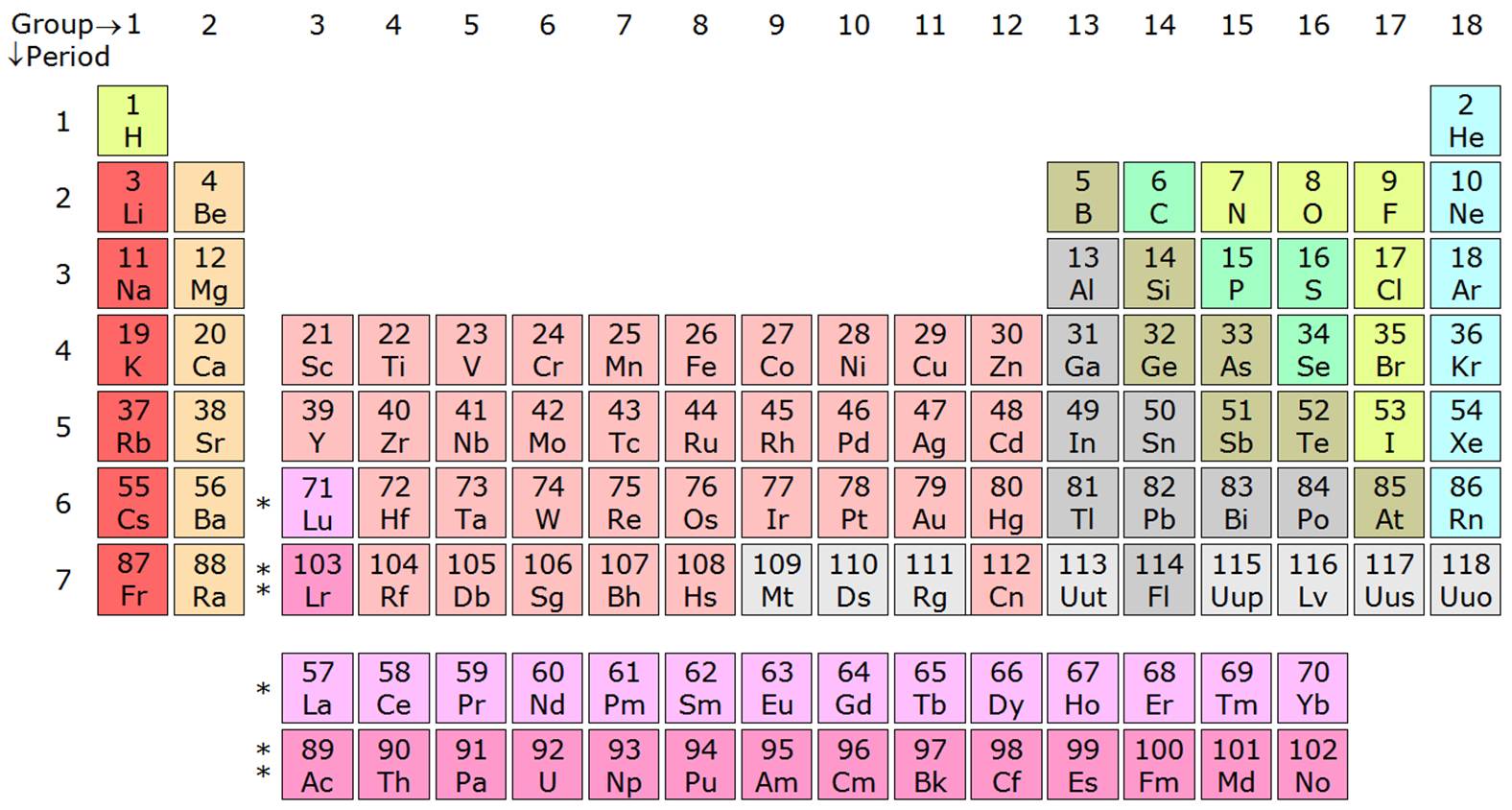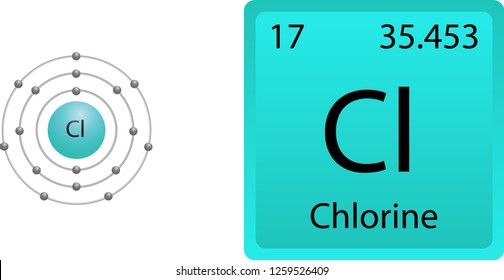Chlorine has two stable isotopes chlorine-35 and chlorine-37with Chlorine-35 accounting for roughly 3 out of every 4 naturally occurring chlorine atoms. Chlorine-36 is also known naturally and is a radioactive isotope with a half life of about 30,000 years. Chlorine (atomic number 17) is a yellowish-green toxic gas. About three quarters of all chlorine atoms have 18 neutrons, giving those atoms a mass number of 35. About one quarter of all chlorine atoms have 20 neutrons, giving those atoms a mass number of 37.
The five elements; Fluorine (F), Chlorine (Cl), Bromine(Br), Iodine (I) and Astatine (At) belonging to VII A Group of the modern periodic table are collectively referred as halogens. The last element Astatine is radioactive and is very short lived hence generally excluded from the study.
- Before a name and symbol are approved, an element may be referred to by its atomic number (e.g., element 120) or by its systematic element name. The systematic element name is a temporary name that is based on the atomic number as a root and the -ium ending as a suffix. For example, element 120 has the temporary name unbinilium.
- 4) The naturally occurring Chlorine isotopes are Chlorine-35 and Chlorine-36. While Chlorine-37 does occur naturally, it is radioactive and unstable. 5) Chlorine has an oxidation state of +5 when it reacts with oxoacids with the Alkali Metals.
- Cl I Ground State 1s 2 2s 2 2p 6 3s 2 3p 5 2 P° 3 / 2 Ionization energy 104591.0 cm-1 (12.96763 eV) Ref. RK69 Cl II Ground State 1s 2 2s 2 2p 6 3s 2 3p 4 3 P 2 Ionization energy 192070 cm-1 (23.8136 eV) Ref. RK74-1 (23.8136 eV) Ref.
The word halogen is derived from the Greek words Halos (Sea Salt) and Genes (Producer). Since the binary compounds of halogen are the most abundant soluble salts found in the sea. Thus halogen means salt producers.
Electronic Configuration of Halogens:
Sr.No. | Elements | Atomic No. | Electronic Configuration | Configuration of valence shell |
1 | Fluorine (F) | 9 | 2, 7 | 2s2 2p5 |
2 | Chlorine(Cl) | 17 | 2, 8, 7 | 3s2 3p5 |
3 | Bromine(Br) | 35 | 2, 8,18, 7 | 4s2 4p5 |
4 | Iodine (I) | 53 | 2, 8, 18, 8, 7 | 5s2 5p5 |
5 | Astatine (At) | 85 | 2, 8, 18, 32, 18, 7 | 6s2 6p5 |
Characteristic Electronic Configuration of Halogens:
- All halogens contain seven electrons in their outermost shell. All other shells are completely filled. They have characteristic outer orbit configuration of ns2 np5.
- The last electron during configuration occupies p orbital, hence these elements are p block elements.
- All orbits except the last orbit are completely filled. Hence they are normal elements.
- All halogens contain seven electrons in their outermost shell. Hence they are kept in group VII-A (17) of a periodic table, before inert gases.
- There are seven electrons in the outermost shell. So these elements require only one electron to complete the octet.
Properties of Halogens:

Monovalency of Halogens:
All halogen have shell electronic configuration is ns2 np5. They contain seven electrons in the valence shell. They need one electron to complete their octet. They attain the octet either by accepting an electron to form a univalent anion, X-, (F-, Cl-, Br- and I-) by sharing the unpaired electron with the unpaired electron of another atom to form a covalent bond (as in Cl2, Br2, HCI, HF etc). Therefore, the common valency of halogen family is 1. Hence they are monovalent.
Atomic Radius:
Atomic and ionic radius is the distance from the centre of the nucleus to the outermost shell of the atom or ion. From fluorine to iodine atomic radius increases because of following reasons.
Trend: As we go down in the group atomic radius increases from fluorine to iodine.
Explanation: As we go down in the group
- Atomic number and number of shell increases.
- Effective nuclear charge decreases.
- Screening effect increases.
It is to be noted that every ion is larger in size than the corresponding atom.
Oxidation State:
The characteristic electronic configuration of the halogens is ns2 np5. Hence, they tend to gain one electron to form the stable electronic configuration of the nearest noble gas atom and exhibit – 1 uniform oxidation state.
Chlorine, bromine and Iodine have empty n-‘d’ orbital. These elements when combining with the more electronegative element, their electrons of nth orbit get promoted to n-‘d’ orbital. Therefore, they can show positive oxidation states like +1, +3, +5 and +7.
Fluorine has only -1 oxidation state due to the absence of vacant n-’d’ orbitals.
Fluorine has Only -1 Oxidation State:
Fluorine is the most electronegative element having highest electronegativity 4. It does not have ‘d’ orbitals in Its valence shell. So it cannot expand the octet. Hence fluorine has only –1 oxidation state.
Ionization Potential (I.P.) or Ionization Enthalpy:
The energy required to remove outermost electron from the gaseous atom of an element, when it is in the ground state is called ionization potential or ionization enthalpy.
Since atomic radii of halogens are smallest in their respective period, their ionization potentials are very high. They have no tendency to lose the electron.
Among halogens, the I.P. (I.E.) value decreases with Increase in size of atom i.e. from fluorine to iodine. Therefore, the non-metallic properties decrease from fluorine to Iodine. Iodine is solid with metallic lustre.
Fluorine has Highest Ionization Enthalpy:
Ionisation potential is the minimum energy required to remove most loosely bound electron from the outermost shell of an isolated gaseous atom. Fluorine has high. I.P. due to following reasons.

- It has the smallest atomic size
- The last electron present in 2p-orbital, which is nearer to the nucleus.
Therefore the last electron is held more tightly by the nucleus, due to greater nuclear charge. Thus more amount of energy is required to remove that electron and I.P. is more.

Electronegativity (EN):
The relative tendency of the bonded atom in a molecule to attract the shared electron pair towards itself is termed as its electronegativity.
Amongst the elements in the same period, halogens are most electronegative due to high nuclear charge and small atomic size. Their electronegativity and non-metallic character decrease gradually down the group with the increase in their atomic size. Electronegativity values are as follows F = 4, Cl = 3, B r = 2. 8, 1 = 2. 5 (Note: Oxygen electronegativity is 3.51)
Fluorine Show High Electro-negativity:
Electro-negativity is the tendency of an atom to attract shared electrons towards itself in a molecule. Fluorine has high electro-negativity due to following reasons
- It has the smallest atomic size.
- The last orbit is second which is nearer to the nucleus and has a greater nuclear charge.
Therefore, the distance between the shared pair of electrons and nucleus of fluorine is small. Thus it has more ability to attract the shared pair of electrons towards itself and electro-negativity is more.
Electron Affinity (EA):
Electron affinity is the energy released when an electron is added to neutral gaseous atom forming a univalent negative ion. When halogens get electrons they give up energy.
Each halogen has maximum electron affinity in a period but in halogen family, it decreases from fluorine to iodine. The order of electron affinity is, Cl > F> Br > I. It can be explained as follows

- Atomic size increases
- Effective nuclear charge decreases
- Ability to attract electron decreases
- Screening effect increases
Electron Affinity of Fluorine is less than that of Chlorine:
Electron affinity is the energy released when an electron is added to neutral gaseous atom forming a univalent negative ion. The electron affinity of fluorine is less than that of Chlorine. It can be explained as follows.
- Fluorine has an extremely small atomic size.
- 2p sub-shell is compact in fluorine.
- The maximum capacity of the outermost orbit in fluorine is eight electrons only.
Due to above reasons, the added electron comes too close to other valency electrons and this increases electron-electron repulsion. This results liberation of less energy when fluorine atom receives electron and forms F- Ions.
Bond Dissociation Energy (Bond Dissociation Enthalpy):
Bond dissociation energy is defined as the energy required to break a particular bond into atoms.
In general, halogens are diatomic molecules in which covalent bond is formed by overlapping of ‘p’ orbitals. Since atomic size increases from chlorine to Iodine, bond length increases from chlorine to iodine. As bond length increases from Cl to I. Bond dissociation energy decreases from chlorine to Iodine molecule.
Bond Dissociation Energy of Fluorine is Exceptionally Less:
Bond dissociation energy is the energy required to break the bond between the atoms in a gaseous molecule. Bond dissociation energy of F-F bond in F2 is less than Cl2, Br2 because of the following reasons
Fluorine has small atomic size and in fluorine, 2p subshell is compact and close to the nucleus. Due to small atomic size number of electrons are held in a compact volume and there is strong repulsion amongst non bonded electrons. Hence bond becomes weak though bond is short. Due to this reason bond dissociation energy of fluorine less than other halogens.
Multiple bonding takes place in Cl2, Br2, I2, due to the presence of d-orbitals, while such type of multiple bonding is absent in fluorine due to the absence of d-orbitals. Hence bond dissociation energy is high for other halogens. The order of bond dissociation energy is, Cl2 > Br2 > F2 > I2
Bond dissociation energy of fluorine molecule is much less than that of chlorine molecule.
This is because, in fluorine molecule, two fluorine atoms are quite close together (i.e. F-F bond length is very short) due to full size of fluorine atoms. This gives rise to very strong repulsion between the non-bonding electrons of the two atoms. The F-F bond, therefore, becomes weak.
In chlorine molecule, the repulsion is considerably minimised by longer Cl-Cl bond length due to the bigger size of the chlorine atoms.
General Properties of Halogens:
- State: Fluorine and Chlorine are gases, bromine is liquid and iodine is solid.
- Colour: All are coloured and the intensity of colour increases from fluorine to Iodine. Fluorine is light yellow/Pale yellow gas. Chlorine is greenish-yellow gas. Bromine is reddish-brown or Orange-red liquid and Iodine is violet or Shining black solid.
- Melting and Boiling Points: The elements have low boiling and melting points as their molecules are held together by Weak Vander Wall’s forces. These forces become stronger with an increase in atomic size. So boiling and melting points increase from fluorine to Iodine. Thus, fluorine and chlorine are gases, bromine is volatile liquid and Iodine is solid, which easily sublimes.
- Oxidizing Property: Halogens are strong oxidizing agents. Fluorine is the most powerful oxidizing agent. Oxidizing power decreases from fluorine to iodine.
Fluorine is the most powerful oxidizing agent:
- Fluorine has smallest atomic size.
- Fluorine has the highest electronegativity (= 4)
- F-F bond dissociation energy is very low.
- Fluorine atom accepts electron readily to form F- ion. Hence it has high reduction potential Eo Red = +2.87 Volt.

Reasons for Anomalous Behaviour of Fluorine:
How Many Elements Are In Chlorine
Fluorine differs from other halogens due to following reasons
How Many Atoms Are In Chlorine
- Smallest atomic size.
- Highest electronegativity.
- Weak F-F bond i.e. F—F bond dissociation energy is low.
- Non-availability of Id’ orbitals in its valence shell.
- Strongest oxidizing agent (stronger than oxygen)
